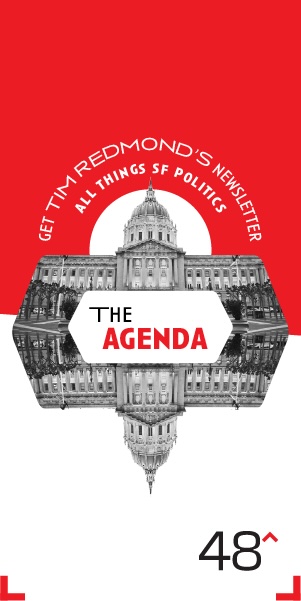By “bad urbanists,” Arieff was referring to techies’ notorious insularity from the world outside their workplaces.
The oft-referred-to ‘serendipitous encounters’ that supposedly drive the engine of innovation tend to happen only with others who work for the same company….I keep coming across instances where the tech sector flocks to the city and talks of community yet isolates itself from the urban experience it presumably couldn’t wait to be a part of.
That aloofness, says Arieff, is having a bad effect on the urban experience in San Francisco, where “tech tenants now fill 22% of all occupied office space” and last year accounted for “a whopping 61% of all office leasing in the city.”
Arieff marked the desolate state of the formerly lively Hills Plaza, adjacent to the burgeoning Google outpost, and the mid-Market environs of the new Twitter headquarters. She noted that Twitter’s move into the former Merchandise Mart was prompted by “considerable—and highly controversial—tax incentives from the city and overwhelming support from Mayor Ed Lee” in the hope of revitalizing the area. But “skyrocketing commercial rents” and a lack of pedestrian activity during the day were warding off small businesses, while evictions in the neighborhood were 38.2% higher in 2013 than in 2012.
So far I was right there with Arieff. Then things got problematic, as she invoked Jane Jacobs as the voice of urban planning and urbanism.
CITIES FOR EVERYONE
Jacobs opened her masterwork, The Death and Life of Great American Cities, by announcing: “This book is an attack on current city planning and rebuilding.”
I suppose that Arieff would contend that since 1961, city planners have taken Jacobs’ criticism to heart and now embrace the democratic vision set forth in the following line from Death and Life, which she quotes: “Cities have the capability of providing something for everybody, only because, and only when, they are created by everybody.”
If only. Today’s planners, imbued with the ideology of smart growth, have to be pressured into “providing something for everybody” and ensuring that everyone has an opportunity to make something of his or her life.
Help us save local journalism!
Every tax-deductible donation helps us grow to cover the issues that mean the most to our community. Become a 48 Hills Hero and support the only daily progressive news source in the Bay Area.
Consider social equity advocates’ vigorous, marginally successful struggle against Plan Bay Area, the region’s new land use/transportation “blueprint,” and its projected displacement of tens of thousands of men, women, and children by gentrifying high-density development.
But there’s one aspect of Jacobs’ urbanism that has been taken up by today’s planners: the “urban experience” denoted in the other passage from Death and Life that Arieff cites: “[The] ballet of the good sidewalk is always replete with new observations.”
This much-reproduced remark refers to the stimulating scene of people negotiating the streets of a great, meaning a diverse and disorderly, city—meeting and greeting, watching the kids play, or just passing by, but in any case out there enlivening the cityscape.
This is what Arieff says the techies’ cloistered ways are draining out of San Francisco’s public spaces, and she’s right. But it captures only a fraction of Jacobs’ urbanism—what might be called the social aesthetics of city life. A satisfying touristic experience provides the same pleasures.
By contrast, Jacobs’ idea of urban greatness was grounded in intense political participation of the sort in which she herself engaged. Unlike the ballet of the good city sidewalk, political activism involves encounters that are only occasionally serendipitous. More often, they’re tedious, and at times downright jarring. But in seeking to alter power relations in favor of what she called citizen “self-government,” they’re also essential to the democratic urbanism Jacobs prized.
It’s possible to imagine tech companies supporting this kind of urbanism: they could donate money to non-profits that are fighting evictions, directly fund affordable housing, and use their influence to repeal the Ellis and the Costa-Hawkins Acts.
WOW — A NEW CAFE
Instead, Arieff’s examples of tech involvement in the community are philanthropic or entrepreneurial:
Zendesk has donated $5,000 to a nearby community garden, has been doing about 40% of its catering through local businesses, and has invited local groups to be guest lecturers.
At 5M, the mixed-use project in the Chronicle building at 5th and Mission, tenants host “numerous public events” and patronize weekly food trucks at lunchtime.
And Jack Dorsey, C.E.O. of Square, invested in Sightglass Coffee, a café and roastery that’s near his office at Square, thereby giving him and “a lot of other people in the neighborhood a place to go.” Maybe,” Arieff, muses, “he can do that somewhere near his other company’s office? It’s Twitter.”
There’s nothing wrong with these gestures. But however well-intentioned, they add up to a paltry urbanist agenda.
To put it differently: the San Franciscans who are protesting the evictions want something that’s more valuable and harder to attain than a hangout or a handout: they want to control their lives and their community.
The crowd last Tuesday was beyond standing room only. The next day, SPUR’s Publications and Communications Manager, Karen Steen, told me that the organization’s usually accurate attendance system had been overwhelmed by the numbers; SPUR estimates that 250 people attended the event. Most of them were young.
At the start, Arieff asked, who here is a planner? a technologist? a planner-technologist? Each question yielded a respectable show of hands.
The forum lasted an hour and a half. The three presenters, all trained as planners but none currently working for public planning agencies, were Molly Turner from Airbnb; Alicia Rouault, a former Code for America fellow who went on to found the startup Local Data; and SPUR Regional Planning Director Egon Terplan.
The speakers were articulate and congenial. We saw some gorgeous and instructive PowerPoints. Turner described her efforts to create a more equitable form of tourism. Rouault considered analogies between planning and tech (the former’s “pilot project,” for example, corresponds to the latter’s “Minimally Viable Product”). Terplan discussed the broad character of city planning and contrasted planner and hacker ethics.
NO GOOGLE BUSES
Remarkably, what never came up were the social, economic, and political troubles that the techie influx has brought into the city. Not once did I hear the words “rent,” “eviction,” or “Google buses.” Nobody asked how planners and techologists might work together to address these matters.
Granted, someone might have tried to raise these issues during the Q & A session. It was impossible to know, since instead of having people raise their hands to be called on (the format followed at all the other SPUR forums I’ve attended), audience members were required to write questions on cards that were passed up to Arieff, who then chose the ones to pose to the panelists.
In the last ten or so minutes, however, she began calling on people.
The third person she called asked the final question. A woman wondered: “Could Code for America consider solutions to some of the bigger problems like affordable housing or crime?”
At last, I thought, we’re getting down to the nitty-gritty.
Rouault started to reply: They could take a “hyperlocal approach” and create an app that makes “more housing information available,” when the two big screens mounted on the walls of the room started to go up. The assemblage of planners, technologists and planner-technologists gawked, as if mesmerized by the display of primitive mechanical movement.
And then, Arieff abruptly adjourned the meeting.
It seems that someone in the packed room had accidentally leaned against the button that controls the screens.
Even so, the aborted exchange made a fitting conclusion to a discursive exercise in bad urbanism.




